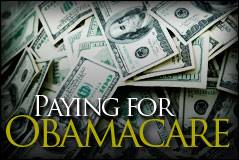Fact Sheet

The Affordable Care Act: Pennsylvania’s Costs
The Patient Protection and Affordable Care Act—often dubbed “Obamacare”—will cost Americans $1.2 trillion from 2012 to 2022 according to the Congressional Budget Office. These projections do not account for the additional costs to state governments or the higher costs for private health insurance.
Unsustainable Welfare Spending
- The Affordable Care Act requires states to expand eligibility for Medicaid (government health insurance for the poor and disabled).
- The expansion will extend Medicaid eligibility to an additional 800,000 Pennsylvanians, placing a quarter of state residents on government insurance.
- Newly eligible Medicaid recipients in Pennsylvania would cost more than $21 billion from 2014 to 2022 according to the Heritage Foundation. While federal tax dollars would cover the majority of this cost, state taxpayers’ costs would range from $1.3 to $5.5 billion.
- The U.S. Supreme Court ruled the federal government cannot force states to increase Medicaid eligibility, making the expansion optional.
- Even without the expansion, Medicaid costs are unsustainable.
- Medicaid currently consumes about 30% of Pennsylvania’s state operating budget.
- Over the past decade, Pennsylvania Medicaid spending increased 83%, nearly twice as much as personal income (45% over the last 10 years).
- The Government Accountability Office projects Medicaid expenditures will continue to grow faster than the economy even without the ACA expansion.
- In addition to expanding Medicaid, the ACA extends entitlements to higher-income households-up to $43,560 per individual or nearly $90,000 for a family of four—by subsidizing the purchase of health insurance through “exchanges.”
Low Quality Care and Higher Costs
- Government programs provide limited access to care and low-quality coverage.
- Currently, one-third of Medicaid providers will not take new patients, according to a study published in the journal Health Affairs.
- Pennsylvania’s aging population, which depends on Medicare, will experience lower quality care as the ACA cuts Medicare Advantage (Medicare plans provided by private companies) and reduces doctor payments, which are already less than private insurance payments.
- The new Independent Payment Advisory Board will ration limited Medicare funds by refusing to cover procedures it deems non-cost effective instead of leaving treatment decisions to the patient.
- As a result of the ACA’s new regulations, many doctors are planning to retire or stop taking new patients.
- The Association of Medical Colleges estimated the United States would face a shortage of 62,900 doctors in just three years under the ACA.
- The Doctors and Patient Medical Association Foundation found 83% of doctors are considering quitting due to government intervention. Similarly, medical malpractice insurer The Doctor’s Company found the ACA is motivating 43% of doctors to retire within the next five years.
- Despite promises from President Obama that insurance costs would decline, premiums throughout Pennsylvania are increasing.
- Highmark raised rates for small businesses by more than 50% in July 2010 and is requesting another 10% hike.
- Blue Cross of Northeastern Pennsylvania was granted rate increases from 9% to 15%.
- Aetna increased Individual Advantage Plan rates by 10%, citing the ACA.
- Nationally, total government and private health care spending is projected to grow by 7.4% in 2014 (when many of the ACA provisions go into effect), and then continue to increase by 6.2% annually through 2021, according to the Centers for Medicare and Medicaid Services.
New Taxes
The ACA includes 20 new taxes on providers, consumers, non-consumers and the health care industry, including:
- Tax on the uninsured: Individuals without the federally mandated level of coverage will pay a tax up to 2.5% of income, beginning January 2014.
- Tax on jobs: Employers with more than 50 employees who don’t provide the mandated level of coverage will be taxed at $2,000 per employee, beginning in 2014. This tax will most likely come out of workers’ salaries or result in higher prices for products and services.
- Taxes on high incomes: Households making at least $250,000 will pay an additional 3.8% tax on dividends, and 0.9% on income above $250,000 on the Medicare payroll tax, effective January 2013.
- Taxes on health insurance and the health care industry: An insurer tax on Medicaid plans will cost Pennsylvania at least $1.1 billion over 10 years as it is phased in from 2014 to 2018. The so-called “Cadillac tax” of 40% on premium health insurance plans worth more than $10,200 for individuals and $27,500 for families begins in 2018. Finally, the ACA levies a 2.3% excise tax on medical device manufacturers, estimated to eliminate about 14,000 to 47,100 jobs, effective 2013.
- Other taxes include a 10% tax on indoor tanning, increased penalties and limitations on Health Savings Accounts, and reduced itemized deductions on personal income taxes for health care costs.
Overall, the ACA taxes will take more than $500 billion from American taxpayers between 2012 and 2022. The cost of these taxes comes to $1,591 per person through 2022, or $6,363 per family of four.
Patient-Centered Alternatives
Policymakers can lower the cost of health care and give patients more control by implementing the following reforms:
- Congress should give states flexibility to manage Medicaid through block grants or waivers, which would reduce mandates tied to federal funds and allow state lawmakers to customize Medicaid to meet the unique needs of Pennsylvanians.
- Congress must even the playing field by allowing individuals to receive the same tax benefits for purchasing insurance as businesses.
- By returning health care policy to the states, state lawmakers can adopt cost-saving reforms that:
- Allow individuals and small businesses to buy insurance across state lines.
- Allow individuals to opt out of certain mandates or buy “mandate-lite” insurance.
- Repeal state laws which drive up the cost of prescription drugs, requiring higher prices than places like Wal-Mart would otherwise charge.
- Adopt tort reform, eliminating frivolous suits, jackpot jury awards, and defensive medicine that drive up the cost of health care.
# # #
For more on Health Care Policy, visit comfdnprod.wpengine.com.